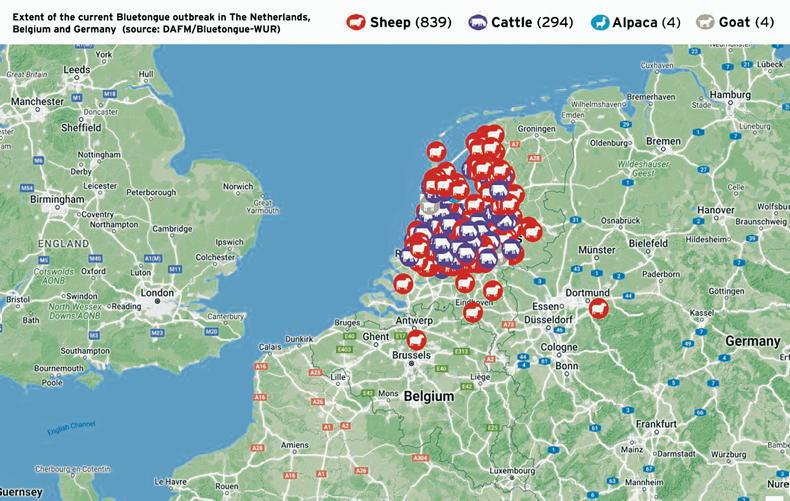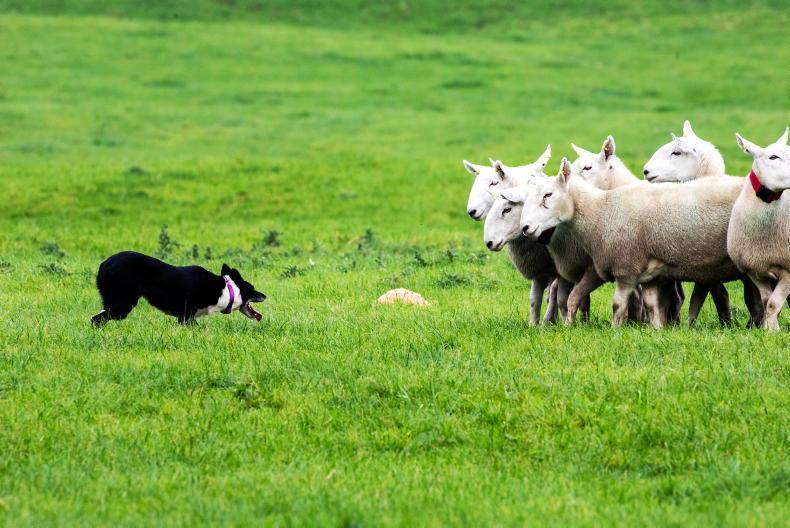While Ireland remains free of Bluetongue, it is present in many European countries.
An outbreak in Ireland would pose a serious threat to the livestock industry here, including trade implications for live animals.
The virus is spread by midges which are most active from April to November, therefore, increased vigilance is essential at this time of the year. Bluetongue is a viral disease which affects ruminants.
Current situation
in Europe
Bluetongue virus serotype 3 (BTV3) was detected in the Netherlands in September 2023. Since then, it has spread rapidly to most of the country. Belgium and Germany have also confirmed outbreaks of BTV3 in sheep in October 2023.
There is no EU-approved vaccine against BTV3 and it is not yet known if other Bluetongue vaccines (BTV8, 1 or 4) can provide cross-protection.
What is Bluetongue and how is it transmitted?
Bluetongue is caused by the Bluetongue virus (BTV) which has 27 known different serotypes several of which are circulating in Europe. The disease does not affect humans or pose a risk to food safety. BTV is primarily spread by midges feeding off the blood of an infected animal and then transferring the virus to another animal by biting them.
The Culicoides species of midges capable of spreading the virus are found in Ireland. Wind dispersal of infected midges can potentially spread the disease over long distances. Weather conditions occasionally favour the wind-borne distribution of midges from continental Europe to Ireland.
The virus can also be spread through biological products such as blood, or as semen or embryos. Infected pregnant animals can pass the virus to their offspring in the womb; these animals are a particularly high-risk group for introducing the virus into Ireland.
What symptoms are
infected animals likely to show?
Susceptible species display clinical signs of the disease to varying degrees, which can range from inapparent to severe.
Clinical signs in sheep are often severe.
Outbreaks in previously unaffected countries have resulted in mortality rates as high as 70% in affected sheep.
Infected cattle and goats tend to show less severe clinical signs and can often carry the disease without showing any signs of illness.
Infected animals that do not show obvious disease can act as hidden carriers of the virus causing further spread of the virus. Clinical signs vary from animal to animal and may include the following:
Swelling of the head
respiratory distressDroolingReddening of tissue surrounding the eyesSores and crusts on the face, mouth and teats,Discharge from the eyes and noseLoss of appetiteDrop in milk yield and abortion. How can we keep the virus out of Ireland?
The importation of an asymptomatic infected animal represents the most significant risk factor for the introduction of BTV into Ireland.
Animals originating from Bluetongue-affected areas are vaccinated against the disease. However, no vaccine is 100% effective for all animals.
Therefore, it is important that risk mitigating actions are taken to prevent an outbreak of Bluetongue in Ireland. All Bluetongue-susceptible animals
imported from mainland Europe, must be tested for the disease following their arrival to Ireland. This testing is carried out by the Department of Agriculture Food and the Marine, for the protection of the national herd and flock.

While Ireland remains free of Bluetongue, it is present in many European countries.
An outbreak in Ireland would pose a serious threat to the livestock industry here, including trade implications for live animals.
The virus is spread by midges which are most active from April to November, therefore, increased vigilance is essential at this time of the year. Bluetongue is a viral disease which affects ruminants.
Current situation
in Europe
Bluetongue virus serotype 3 (BTV3) was detected in the Netherlands in September 2023. Since then, it has spread rapidly to most of the country. Belgium and Germany have also confirmed outbreaks of BTV3 in sheep in October 2023.
There is no EU-approved vaccine against BTV3 and it is not yet known if other Bluetongue vaccines (BTV8, 1 or 4) can provide cross-protection.
What is Bluetongue and how is it transmitted?
Bluetongue is caused by the Bluetongue virus (BTV) which has 27 known different serotypes several of which are circulating in Europe. The disease does not affect humans or pose a risk to food safety. BTV is primarily spread by midges feeding off the blood of an infected animal and then transferring the virus to another animal by biting them.
The Culicoides species of midges capable of spreading the virus are found in Ireland. Wind dispersal of infected midges can potentially spread the disease over long distances. Weather conditions occasionally favour the wind-borne distribution of midges from continental Europe to Ireland.
The virus can also be spread through biological products such as blood, or as semen or embryos. Infected pregnant animals can pass the virus to their offspring in the womb; these animals are a particularly high-risk group for introducing the virus into Ireland.
What symptoms are
infected animals likely to show?
Susceptible species display clinical signs of the disease to varying degrees, which can range from inapparent to severe.
Clinical signs in sheep are often severe.
Outbreaks in previously unaffected countries have resulted in mortality rates as high as 70% in affected sheep.
Infected cattle and goats tend to show less severe clinical signs and can often carry the disease without showing any signs of illness.
Infected animals that do not show obvious disease can act as hidden carriers of the virus causing further spread of the virus. Clinical signs vary from animal to animal and may include the following:
Swelling of the head
respiratory distressDroolingReddening of tissue surrounding the eyesSores and crusts on the face, mouth and teats,Discharge from the eyes and noseLoss of appetiteDrop in milk yield and abortion. How can we keep the virus out of Ireland?
The importation of an asymptomatic infected animal represents the most significant risk factor for the introduction of BTV into Ireland.
Animals originating from Bluetongue-affected areas are vaccinated against the disease. However, no vaccine is 100% effective for all animals.
Therefore, it is important that risk mitigating actions are taken to prevent an outbreak of Bluetongue in Ireland. All Bluetongue-susceptible animals
imported from mainland Europe, must be tested for the disease following their arrival to Ireland. This testing is carried out by the Department of Agriculture Food and the Marine, for the protection of the national herd and flock.








 This is a subscriber-only article
This is a subscriber-only article











SHARING OPTIONS: